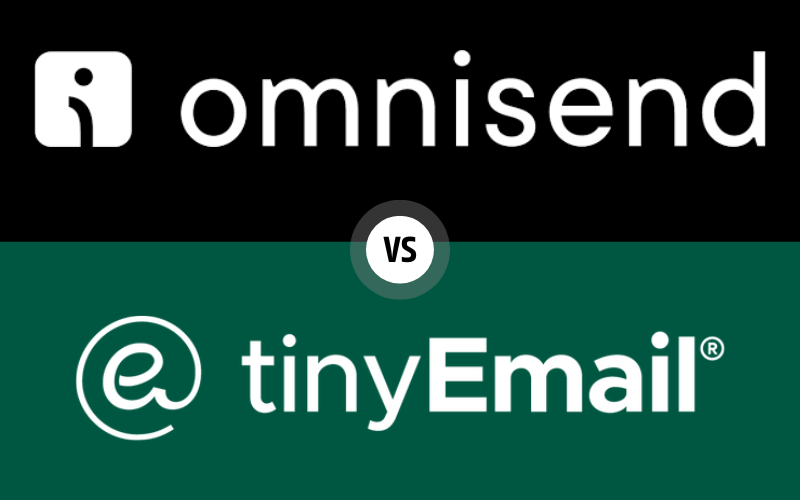In the Omnisend vs TinyEmail debate, choosing the right email marketing platform can be a pivotal decision for marketers looking to elevate their digital strategy. This detailed comparison will explore a variety of critical features—from user interface to advanced segmentation—to help you discern which service, Omnisend or TinyEmail, aligns best with your business’s email marketing objectives. With both platforms offering a host of tools designed to enhance outreach and engagement, our in-depth analysis aims to provide clear insights for both new and experienced marketers. Join us as we dive into each platform, unpacking their offerings to guide you toward the email marketing solution that promises to amplify your campaign’s impact.
Table of Contents
Ease of Use and Interface
In the realm of email marketing platforms, a seamless user experience coupled with an intuitive interface can greatly enhance workflow efficiency. As we compare Omnisend vs TinyEmail, it’s imperative to understand how each platform caters to these aspects. So, let’s dive deep into the user experience and design functionalities of both.
Omnisend
Omnisend’s dashboard, designed with the user in mind, radiates simplicity and efficiency. From initiating a new campaign to accessing intricate subscriber details, every feature seems to be only a few clicks away. Their drag-and-drop editor is particularly noteworthy, catering especially to those who may not be tech experts but still aim to curate professional-grade emails.
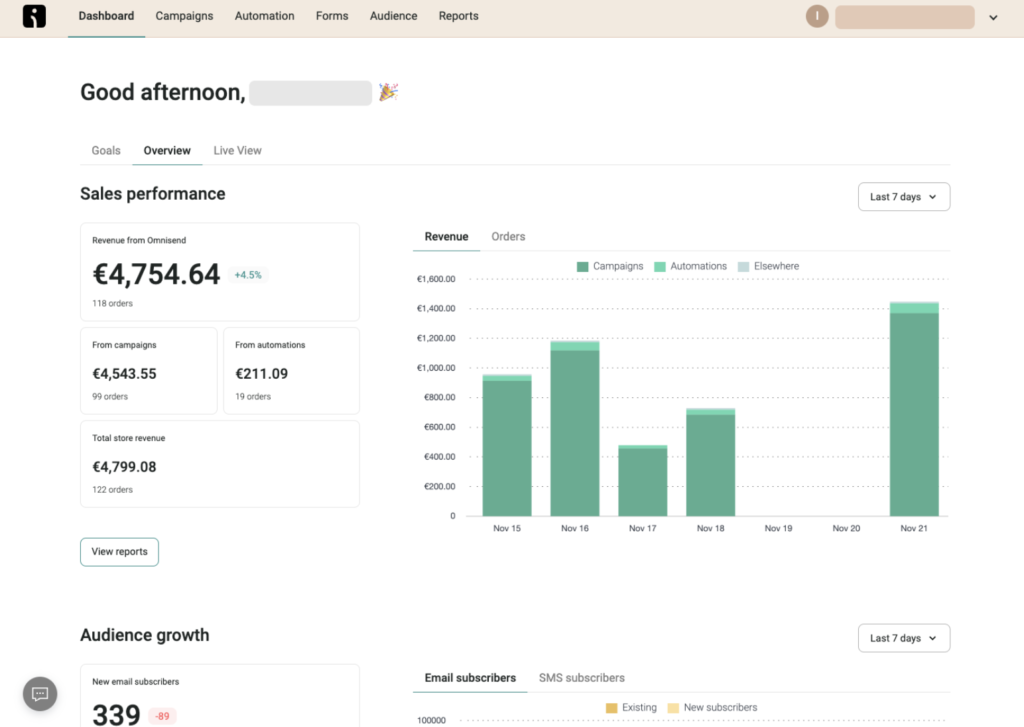
TinyEmail
Prioritizing minimalism, TinyEmail boasts a clutter-free interface that speaks of pure functionality. It might not have the flashy design elements like some competitors, but it excels in delivering a straightforward user experience. Its no-nonsense approach ensures that users can quickly get started without a steep learning curve.

Comparison
In the Omnisend vs TinyEmail ease of use and interface battle, your preference will essentially boil down to what you value more: a visually appealing interface teeming with tools (Omnisend) or a streamlined, straightforward experience (TinyEmail). Both have their unique strengths, and the ideal choice would be contingent on individual or business requirements.
Email Design and Templates
When discussing email marketing, the visual appeal and flexibility of email templates play an indispensable role. They’re the first impression subscribers get, so they have to be on point. Let’s delve into how Omnisend and TinyEmail address this pivotal aspect of their platforms.
Omnisend
Omnisend steps up to the plate with a rich array of pre-designed templates, suitable for a multitude of campaigns ranging from product launches to newsletters. Each template is responsive, ensuring it displays optimally across various devices. Moreover, their easy-to-use design editor lets users customize these templates, tweaking them to align perfectly with their brand identity.

TinyEmail
TinyEmail adopts a different philosophy. While they offer fewer ready-to-use templates than some of their competitors, the ones they do offer are exceptionally well-designed, focusing on clarity and engagement. They prioritize quality over quantity. Their design tool is user-friendly, allowing even beginners to craft visually appealing emails from scratch if they wish.
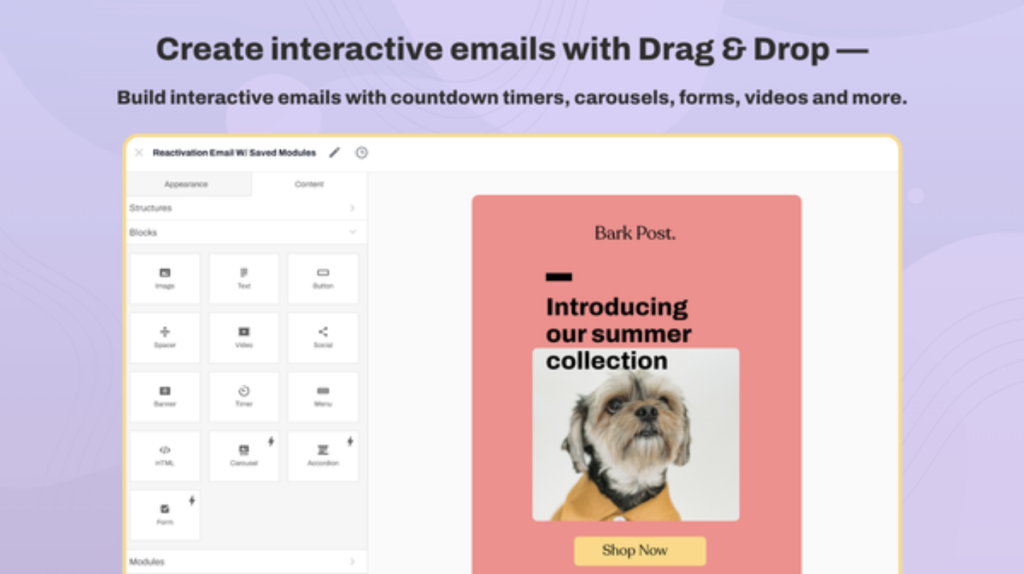
Comparison
In the face-off between Omnisend vs TinyEmail in the realm of email design and templates, both platforms have evident strengths. Omnisend’s plethora of template options offers versatility, while TinyEmail emphasizes quality and user empowerment. The ultimate decision will be based on whether you prefer having numerous templates at your disposal or a more refined, albeit limited, selection that prioritizes quality.
Automation Capabilities
Automation capabilities in email marketing can make the difference between a time-consuming campaign and one that runs seamlessly in the background, ensuring timely and relevant communication with subscribers. When we place Omnisend and TinyEmail under the microscope, how do their automation functionalities stack up? Let’s find out.
Omnisend
Omnisend presents a robust suite of automation tools tailored to the modern marketer. Their automation workflows are designed to cater to various scenarios – be it welcoming a new subscriber, cart abandonment reminders, or re-engaging inactive users. The platform allows for multi-step workflows with intricate triggers and conditions, empowering businesses to set up campaigns that respond dynamically to subscriber behavior.
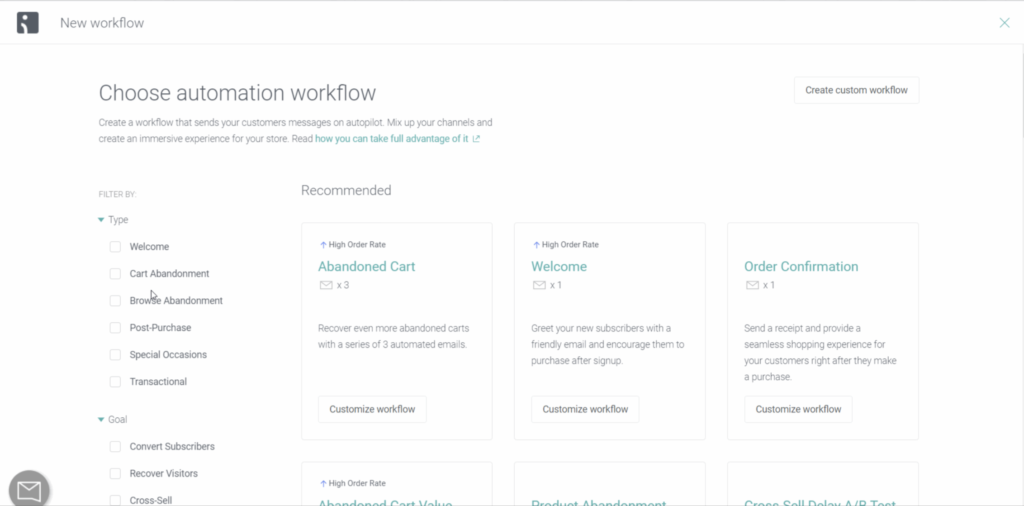
TinyEmail
While TinyEmail might not boast the extensive list of automation templates that some competitors offer, it excels in its intuitive design. Setting up basic automation sequences, like drip campaigns or birthday greetings, is straightforward. What’s notable is the platform’s focus on delivering consistent results with minimal setup, making it a suitable choice for those who prefer a no-frills yet effective approach.

Comparison
In the Omnisend vs TinyEmail debate centered on automation capabilities, the distinction is clear. Omnisend leans towards a more comprehensive, detailed approach, offering a range of advanced workflows. In contrast, TinyEmail champions simplicity, ensuring even those new to email marketing can set up effective automated campaigns. Your choice would hinge on whether you seek in-depth customization or a streamlined, uncomplicated setup.
Segmentation and Personalization
Segmentation and personalization are the cornerstones of targeted email marketing, allowing you to deliver relevant content to the right audience. The Omnisend vs TinyEmail comparison on these aspects reveals how each platform helps you to tailor your messaging to match your subscribers’ preferences and behaviors.
Omnisend
Omnisend offers advanced segmentation features, enabling marketers to divide their audience based on shopping behavior, campaign engagement, and more. Their segmentation capabilities are quite detailed, allowing for dynamic content insertion based on each segment, which can dramatically increase the relevance of the campaigns. Personalization goes beyond just ‘first name’ and ‘last purchase,’ it digs deep into user data to craft highly personalized messages.

TinyEmail
TinyEmail keeps segmentation simpler but effective, focusing on the most actionable customer data. Users can segment their lists based on demographics, open rates, or click-through rates, which is generally sufficient for small to medium-sized businesses. Personalization with TinyEmail is straightforward, focusing on creating a more personal connection with the subscribers through basic data points.

Comparison
When assessing Omnisend vs TinyEmail on segmentation and personalization, it’s a balance between complexity and simplicity. Omnisend offers more granular control, which is ideal for larger businesses or those with a diverse product range, while TinyEmail caters to businesses that want simplicity and speed in campaign setup. The best platform for you would depend on the level of detail and customization you require from your segmentation and personalization efforts.
List Management and Import
Effective list management and import features are essential for growing and maintaining a healthy email subscriber base. The comparison between Omnisend and TinyEmail in this domain is crucial for users who need efficient ways to manage their contacts.
Omnisend
Omnisend shines with its robust list management system. Users can easily import their contacts via CSV files, integrate with their ecommerce platform, or use APIs for a more automated approach. Omnisend supports tagging and even complex segmentations within the list management console, ensuring that users can keep their lists as organized as possible.
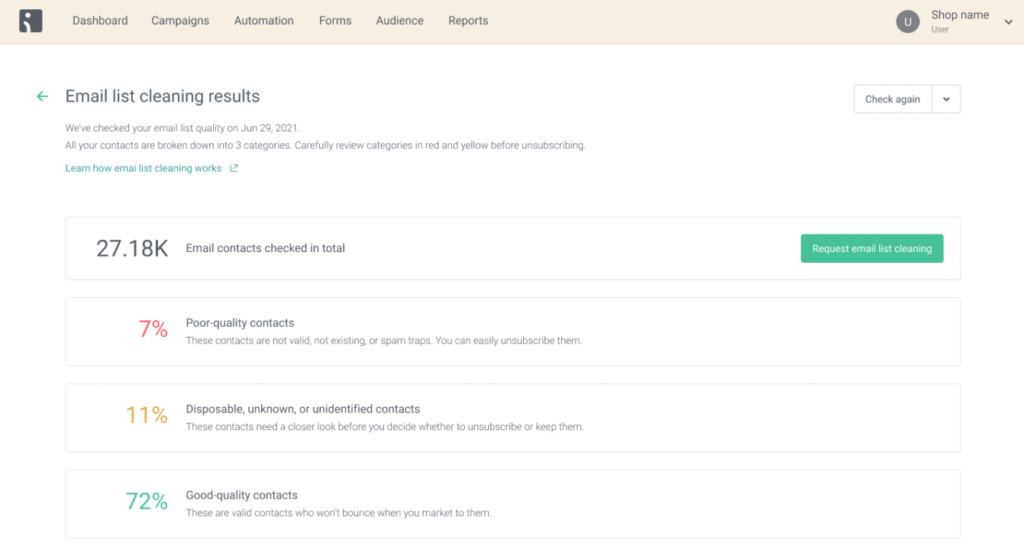
TinyEmail
TinyEmail offers a more straightforward approach to list management and import. It’s designed for speed and ease, allowing for quick import of contacts from various sources. While it may lack some of the advanced features of Omnisend, it covers all the basics. TinyEmail makes it easy for users to add, remove, and manage subscribers, ensuring that even those with minimal technical skills can maintain their email lists effectively.

Comparison
In the battle of Omnisend vs TinyEmail for list management and import capabilities, the decision hinges on the user’s needs. Omnisend provides a suite of features perfect for those who want detailed control and have complex lists. On the other hand, TinyEmail is suitable for users who prefer a no-frills, user-friendly system that gets the job done with minimal fuss. The scale and strategy of your email marketing efforts will dictate which tool better suits your operations.
Integration Capabilities
When it comes to maximizing the effectiveness of email marketing tools, integration capabilities can make or break the user experience. The comparison between Omnisend and TinyEmail regarding their ability to integrate with other systems is a key consideration for businesses looking to streamline their marketing efforts.
Omnisend
Omnisend’s platform is designed to integrate seamlessly with a wide array of ecommerce platforms, CRM systems, and third-party apps. Its extensive library of integrations enables users to connect their email marketing campaigns with their online store, customer databases, and other essential marketing tools, providing a cohesive and automated workflow.

TinyEmail
TinyEmail may not boast the extensive integration marketplace that Omnisend does, but it offers focused integrations that cover the essentials needed for small to medium-sized businesses. With a straightforward approach, TinyEmail ensures that the most commonly used services, such as major ecommerce platforms and a selection of CRM systems, can be easily linked with their tool.

Comparison
When evaluating TinyEmail vs Omnisend based on integration capabilities, your platform of choice will depend on the complexity of your tech stack and the specific tools you are looking to integrate with. Omnisend offers a broader range for those who need a diverse set of integrations, while TinyEmail caters to users who need straightforward, essential integrations without the complexity. Your marketing strategy’s scope and the other tools in your marketing suite will guide your decision on which email marketing tool to use.
Deliverability Rates
Understanding deliverability rates is crucial when comparing email marketing platforms like Omnisend and TinyEmail, as it determines the likelihood of your emails actually reaching the inbox. Let’s evaluate how each platform ensures high deliverability rates.
Omnisend
Omnisend prides itself on high deliverability rates, thanks to their robust email infrastructure and adherence to best email practices. By employing dedicated IP addresses and proactive monitoring, Omnisend maintains a reputable sender status. This helps ensure emails consistently reach the intended recipient’s inbox, avoiding spam filters.
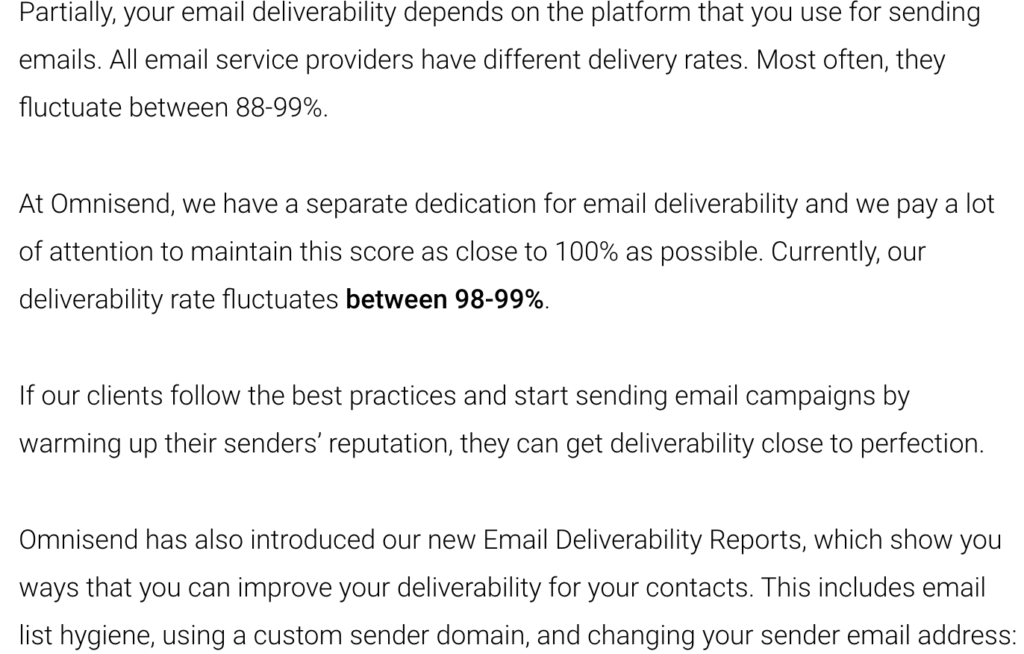
TinyEmail
TinyEmail emphasizes deliverability through their smart sending features and automated list management, which helps clean your email list and avoid sending emails to unengaged subscribers. Their system automatically optimizes sending times for maximum open rates, contributing to maintaining a positive sending reputation.

Comparison
The Omnisend vs TinyEmail comparison in terms of deliverability rates isn’t just about the numbers; it’s about the strategies and technologies each platform uses to achieve those numbers. While Omnisend focuses on maintaining a high sender reputation through dedicated IPs and monitoring, TinyEmail uses intelligent list management and sending features to keep deliverability rates up. Potential users should consider which approach aligns best with their email marketing strategy and the level of control they wish to have over the deliverability aspect.
Reporting and Analytics
In the face of stiff competition between Omnisend and TinyEmail, the ability to track performance through reporting and analytics is a deciding factor for many businesses. Both platforms offer insights, but let’s dissect how each one helps you measure success.
Omnisend
Omnisend’s reporting and analytics are comprehensive, giving you a panoramic view of your campaigns’ performance. Their dashboard provides real-time data, allowing you to track opens, clicks, conversions, and sales. The reports are customizable, enabling you to delve into the metrics that matter most to your business.

TinyEmail
TinyEmail, on the other hand, offers streamlined analytics that focus on the essentials. They provide clear and concise reports that are easy to understand, making it simple for users to glean insights without getting bogged down in data. TinyEmail ensures that even those with minimal analytical experience can make informed decisions about their email campaigns.

Comparison
When weighing Omnisend vs TinyEmail in terms of reporting and analytics, it’s a balance between depth and simplicity. Omnisend caters to those who crave detailed data and the ability to dig deep into analytics, while TinyEmail appeals to users who prefer a straightforward, no-frills approach to understanding campaign performance.
Customer Support and Resources
The quality of customer support and the resources available can greatly influence the user experience with email marketing platforms. In the TinyEmail vs Omnisend comparison, let’s consider how each service supports its users through trouble-shooting and education.
Omnisend
Omnisend takes pride in offering robust customer support. Users have access to a range of support options including live chat, email support, and a comprehensive knowledge base filled with useful guides and tutorials. For more complex issues or guidance, Omnisend provides dedicated account managers to certain plan tiers, ensuring personalized assistance.
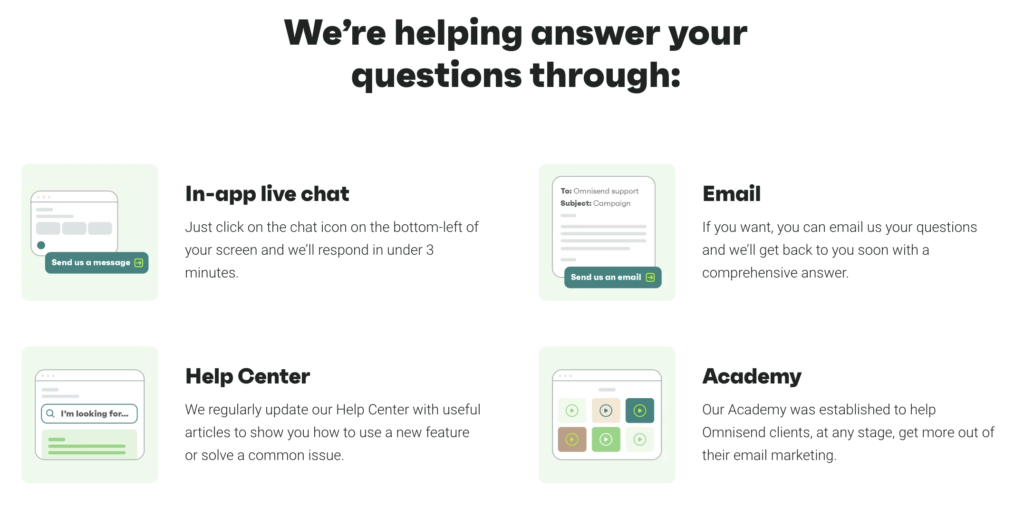
TinyEmail
TinyEmail emphasizes efficient and responsive customer support. Although they may not offer the breadth of support channels that Omnisend does, their focus is on quick resolution times and direct assistance. Their resources are curated to get you up to speed quickly, featuring FAQs, quick start guides, and a selection of targeted how-to articles.

Comparison
In evaluating Omnisend vs TinyEmail on the customer support front, it’s a toss-up between comprehensive, multi-tiered support (Omnisend) and fast, streamlined assistance (TinyEmail). While Omnisend offers a more extensive range of support options, TinyEmail focuses on delivering quick solutions.
Pricing and Plans
Understanding the pricing structure and plans is a critical step when choosing an email marketing platform. The showdown between Omnisend vs TinyEmail in terms of cost-effectiveness can be decisive for businesses looking to maximize their investment.
Omnisend
Omnisend offers a tiered pricing strategy to accommodate businesses of varying sizes and needs. They feature a free plan with basic features, which is great for startups and small businesses just dipping their toes into email marketing. As businesses grow, Omnisend’s paid plans provide advanced features such as segmentation, automation, and more in-depth reporting. Each increase in plan tier correlates with access to additional features and higher sending limits.

TinyEmail
TinyEmail aims to be accessible by offering competitive pricing with a focus on simplicity. They may not have a free tier, but their starting plan is reasonably priced and packs in essentials for effective email campaigns. Their pricing scales as the number of subscribers increases, making it straightforward for businesses to understand their monthly expenses as they scale.

Comparison
Comparing Omnisend vs TinyEmail for pricing and plans reveals a distinction between a more traditional tiered pricing model and a straightforward scaling approach. Omnisend’s free plan might be a draw for new businesses, while TinyEmail’s affordable entry-level plan could attract those willing to invest a small amount for quality features from the get-go.
Security and Compliance
In an era where data breaches are commonplace, security and compliance are non-negotiable aspects of any digital tool, particularly in email marketing. Let’s compare how Omnisend and TinyEmail stack up in this essential domain.
Omnisend
Omnisend demonstrates a strong commitment to security by employing industry-standard practices such as SSL/TLS encryption for data in transit and at rest. They are transparent about their security protocols, which also include regular penetration testing to prevent breaches.
Compliance is another strong suit for Omnisend. They adhere to international standards, including GDPR for European customers, ensuring user data is handled with the utmost care. They offer features to help their customers maintain compliance, such as easy-to-use consent checkboxes and data management tools.

TinyEmail
TinyEmail places a significant emphasis on security with a clear privacy policy that outlines how data is collected, used, and protected. Their investment in robust security infrastructure is designed to safeguard against the most common cyber threats.
On the compliance front, TinyEmail covers the essentials by maintaining adherence to GDPR and other relevant data protection regulations. They also provide users with features that aid in maintaining their own compliance, which is a significant advantage for businesses that are conscious of data laws.

Comparison
When weighing Omnisend vs TinyEmail on security and compliance, it’s evident that both platforms prioritize the protection of their customers’ data. While Omnisend impresses with their transparent security practices and comprehensive compliance tools, TinyEmail counters with strong foundational security measures and essential compliance coverage. The choice might come down to the specific security features and compliance aids each business requires.
Mobile Optimization
In the fast-paced mobile-centric world, the ability of email marketing platforms to provide mobile optimization is a deciding factor for many businesses. Here’s how Omnisend and TinyEmail ensure that their services are up to the task.
Omnisend
Omnisend acknowledges the importance of mobile optimization by offering responsive email design templates that adapt seamlessly to any screen size. Their platform allows you to preview how your emails will look on mobile devices before sending them, ensuring every campaign looks professional on any device.
Moreover, Omnisend’s mobile-responsive forms and landing pages ensure that subscribers have a consistent experience across all touchpoints. This level of mobile optimization may prove crucial for businesses with a large number of mobile users.

TinyEmail
TinyEmail also comes equipped with mobile-optimized email templates, ensuring that readability and usability are not compromised on smaller screens. The platform’s editing tools make it easy to create emails that are not only visually appealing on desktops but also on smartphones and tablets.
The emphasis on simplicity extends to their mobile view as well, presenting users with an uncompromised experience when managing campaigns on the go. TinyEmail’s analytics tools also help track the performance of mobile-optimized campaigns, which is a vital asset for marketers focused on mobile engagement.

Comparison
Comparing Omnisend vs TinyEmail for mobile optimization, both platforms clearly understand the necessity of mobile-friendly designs. Omnisend provides a slightly broader range of mobile-responsive options, including forms and landing pages, while TinyEmail focuses on straightforward, no-frills mobile optimization with a keen eye on performance analytics. For businesses aiming for a strong mobile presence, both services offer compelling features, but the final decision may rest on whether they value additional mobile-responsive features or a lean approach to mobile optimization.
Feedback and Reviews
Customer feedback and reviews are invaluable for businesses seeking to improve their products and services. Let’s evaluate how Omnisend and TinyEmail incorporate feedback mechanisms and what the reviews say about their performance.
Omnisend
Omnisend has implemented an intuitive system for gathering customer feedback, which is straightforward for users to navigate. They actively encourage users to review their experience, showing a commitment to transparency and continuous improvement.
Online reviews about Omnisend often praise its advanced automation features and customer support. However, some users mention a learning curve when starting out. Overall, the feedback is positive, with many noting the platform’s effectiveness in boosting their marketing efforts.

TinyEmail
TinyEmail values user input, providing easy-to-use feedback forms directly within their platform. They use this feedback to refine their offerings and ensure that their tool evolves according to user needs.
Reviews of TinyEmail generally highlight its ease of use and excellent value for money. Some users may desire more advanced features, which are typically found in more established platforms. Positive reviews often underscore the platform’s user-friendly approach and reliable delivery rates.

Comparison
In comparing Omnisend vs TinyEmail regarding feedback and reviews, both platforms show strengths in different areas. Omnisend is often celebrated for its robust features and strong customer support, while TinyEmail is lauded for its simplicity and cost-effectiveness. The key takeaway from user reviews is that Omnisend may be better suited for those needing advanced functionality, whereas TinyEmail is ideal for those who prioritize ease of use and affordability.
Scalability
Scalability is a crucial factor when considering an email marketing platform, as it directly impacts a business’s ability to grow and adapt to increasing demands. Here’s how Omnisend and TinyEmail stack up in terms of scalability.
Omnisend
Omnisend demonstrates strong scalability features, catering to both small businesses and larger enterprises. The platform offers a range of plans that can accommodate growing subscriber lists and increased email volumes. Additionally, Omnisend’s advanced automation and segmentation capabilities are designed to handle complex marketing campaigns, which can scale as a business expands.
The scalability of Omnisend is also evident in its multi-channel marketing approach, allowing businesses to grow their reach beyond email to SMS and social media through the same platform.

TinyEmail
TinyEmail offers scalability in a slightly different vein, focusing on simplicity and ease of use, even as businesses grow. The platform provides a straightforward pricing model that scales with the number of subscribers, making it simple for businesses to understand and anticipate costs associated with growth.
While TinyEmail may not offer as broad a range of features as some larger competitors, it still provides essential tools that can support the scaling process, such as basic automation and list segmentation.

Comparison
The Omnisend vs TinyEmail comparison in terms of scalability is a tale of two philosophies: Omnisend focuses on feature richness and cross-channel marketing scalability, while TinyEmail champions uncomplicated scaling with an easy-to-manage platform. Ultimately, the choice between them depends on the complexity of your marketing strategies and the depth of features you require to scale your business.
Conclusion: Omnisend vs TinyEmail
Choosing the right email marketing tool is a decision that holds considerable weight for the future of any business. In the Omnisend vs TinyEmail debate, both platforms have their merits and potential drawbacks, depending on your business’s specific needs and growth trajectory.
Omnisend is a robust choice for those who desire a comprehensive, feature-rich platform with advanced automation, segmentation, and multi-channel marketing capabilities. It’s designed to scale from small to large enterprises seamlessly, offering a suite of tools that can elevate a marketing strategy to new heights.
TinyEmail, on the other hand, is the go-to for businesses looking for straightforward, no-frills email marketing. Its strengths lie in its ease of use and clear pricing structure, which makes scaling up—or down—a clear-cut process. For those who prefer a focused approach to email marketing without the complexity of additional channels, TinyEmail offers a compelling proposition.
Ultimately, both platforms provide solid foundations for your email marketing endeavors. Your decision may hinge on whether you’re looking for an all-in-one solution with bells and whistles (Omnisend) or a streamlined service that masters the essentials (TinyEmail).
Remember, the best choice is the one that aligns with your current needs while also paving the way for future growth. It’s about finding the right partner to help your business communicate effectively, reach its audience, and grow sustainably in the digital marketing space.
As you weigh your options, consider not only where your business stands today but where you envision it tomorrow. With the right email marketing platform, the potential is limitless.
Further Reading
As we conclude our exploration of Omnisend vs TinyEmail, you might find these comparisons between TinyEmail and other email marketing tools insightful:
- Campaign Monitor vs TinyEmail: Delve deeper into how TinyEmail sizes up to the features and offerings of Campaign Monitor. Read More.
- Mailchimp vs TinyEmail: Grasp the nuances of Mailchimp’s vast toolset in contrast with the streamlined experience of TinyEmail. Discover the Comparison.
- Moosend vs TinyEmail: A close look at Moosend’s strengths might provide a new perspective on how it compares with TinyEmail’s approach. Learn More.
- GetResponse vs TinyEmail: Explore the dynamic functionalities of GetResponse against the backdrop of TinyEmail’s services. Dive Deeper.
These curated pieces will extend your understanding of the email marketing landscape, helping you to make the most informed choice for your needs. Keep reading and stay updated with our latest insights!


